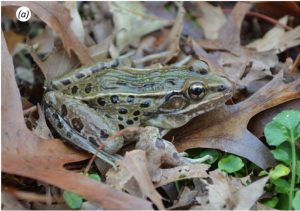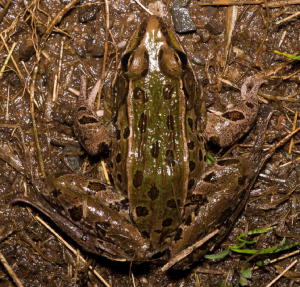The Atlantic Coast Leopard Frog – Uncovering the past
by Taylor Forster, GIS Intern

On a Tuesday morning, Conserve Wildlife Foundation of New Jersey biologist Allegra Mitchell and I, GIS Intern Taylor Forster, went to the New Jersey State Museum in Trenton. We were looking at a newly identified species recently found in one of the largest metropolitan areas – New York! I learned that this species was discovered because of its unique “call.” A “call” is the sound a male frog makes to attract a female frog, and each frog species’ call is unique. It seems that this species remained undiscovered for so long because of its similar appearance to other, closely-related leopard frog species. The cryptic nature of this new species meant that the only noticeable distinction between it and other leopard frogs was the sound it makes.
After looking at this newly discovered frog, now known as the mid-Atlantic coast leopard frog, a few defining characteristics came to light that set it apart from the other leopard frogs. These characteristics make it easier to identify other mid-Atlantic coast leopard frogs that have been preserved and categorized as other species for museum collections. With this information in mind, Ms. Mitchell and I were at the New Jersey State Museum to investigate when and where this frog had been found throughout the state before anyone realized its significance.
After looking through the New Jersey State museum’s collections, eight of the 38 frogs we examined were re-identified as the new species! This information gives us insight as to where these frogs were historically located. In fact, the earliest recorded specimen was found in Morris county in 1955! We can use this information to compare their locations from the past to where they are now, giving us a better idea about their population – if it is decreasing and why. This trip to the New Jersey State Museum gave us priceless insight into the past to help preserve this species in the future.

When doing some background research to prepare for my trip to the museum, I learned that these frogs move from upland areas after hibernation to wetland areas for breeding. This migration is sometimes perilous for these frogs since many have to cross busy roads, especially at night and in the rain. Unfortunately, we all know that driving at night in the rain makes it more difficult to see and makes crossing roads more difficult for everyone, including small, slow-moving amphibians. If we can connect their upland habitat with their wetland habitat so that their journey to the breeding area is a bit safer we can help save mid-Atlantic coast leopard frogs and other amphibians so that they can reproduce and keep population sizes up. We need to keep these cute frogs around for all of the benefits they provide to the ecosystem, including eating mosquitoes and ticks!
Creating passageways between important wildlife habitat is one of the goals of the New Jersey Division of Fish and Wildlife’s state-wide Connecting Habitat Across New Jersey (CHANJ) initiative. CHANJ products and strategies will help land-use managers, conservationists, and transportation planners make our landscape and roadways more permeable to wildlife movement. More information on CHANJ can be found here: http://www.state.nj.us/dep/fgw/ensp/chanj.htm. In the case of the mid-Atlantic coast leopard frog, which likes to hang around urban wetlands, fragmented habitats could be one factor contributing to discrepancies between historical and current population locations.
If you want to get involved and help save amphibians – like the mid-Atlantic coast leopard frog – you can volunteer for CWF’s new Kauffeld’s Calling Frogs program. Similar to other amphibian call monitoring programs, volunteers will collect data on mid-Atlantic coast leopard frog population locations by listening for their calls. This new program will start with February training sessions throughout the state. Check out CWF’s Facebook page for training and program information!
You can also volunteer with the Amphibian Crossing Project in Sussex and Warren Counties. The Amphibian Crossing Project is exactly what it sounds like – volunteers help amphibians cross busy roads during major migration nights each spring. To learn more about this project, visit the Amphibian Crossing Project webpage: http://www.conservewildlifenj.org/protecting/projects/amphibian_crossing/
Check out CWF’s numerous conservation projects on our website: http://www.conservewildlifenj.org/protecting/projects/. Your support through volunteer work, donations, or simply spreading the conservation word to friends and family helps us preserve New Jersey’s rare and imperiled species now and for the future.
Discover more from Conserve Wildlife Foundation of NJ
Subscribe to get the latest posts sent to your email.